c-Fos activates and physically interacts with specific enzymes of the pathway of synthesis of polyphosphoinositides
- PMID: 21998197
- PMCID: PMC3237616
- DOI: 10.1091/mbc.E11-03-0259
c-Fos activates and physically interacts with specific enzymes of the pathway of synthesis of polyphosphoinositides
Abstract
The oncoprotein c-Fos is a well-recognized AP-1 transcription factor. In addition, this protein associates with the endoplasmic reticulum and activates the synthesis of phospholipids. However, the mechanism by which c-Fos stimulates the synthesis of phospholipids in general and the specific lipid pathways activated are unknown. Here we show that induction of quiescent cells to reenter growth promotes an increase in the labeling of polyphosphoinositides that depends on the expression of c-Fos. We also investigated whether stimulation by c-Fos of the synthesis of phosphatidylinositol and its phosphorylated derivatives depends on the activation of enzymes of the phosphatidylinositolphosphate biosynthetic pathway. We found that c-Fos activates CDP-diacylglycerol synthase and phosphatidylinositol (PtdIns) 4-kinase II α in vitro, whereas no activation of phosphatidylinositol synthase or of PtdIns 4-kinase II β was observed. Both coimmunoprecipitation and fluorescence resonance energy transfer experiments consistently showed a physical interaction between the N-terminal domain of c-Fos and the enzymes it activates.
Figures


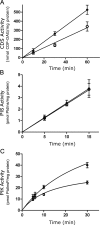
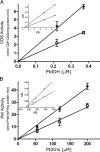
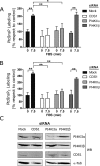

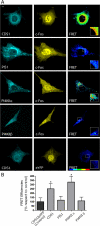

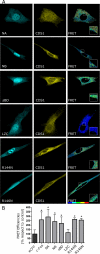
Similar articles
-
c-Fos-activated synthesis of nuclear phosphatidylinositol 4,5-bisphosphate [PtdIns(4,5)P₂] promotes global transcriptional changes.Biochem J. 2014 Aug 1;461(3):521-30. doi: 10.1042/BJ20131376. Biochem J. 2014. PMID: 24819416
-
c-Fos associates with the endoplasmic reticulum and activates phospholipid metabolism.FASEB J. 2001 Mar;15(3):556-8. doi: 10.1096/fj.00-0446fje. Epub 2001 Jan 5. FASEB J. 2001. PMID: 11259365
-
c-Fos activates glucosylceramide synthase and glycolipid synthesis in PC12 cells.J Biol Chem. 2008 Nov 7;283(45):31163-71. doi: 10.1074/jbc.M709257200. Epub 2008 Sep 10. J Biol Chem. 2008. PMID: 18784083 Free PMC article.
-
Impairing activation of phospholipid synthesis by c-Fos interferes with glioblastoma cell proliferation.Biochem J. 2020 Dec 11;477(23):4675-4688. doi: 10.1042/BCJ20200465. Biochem J. 2020. PMID: 33211090
-
c-Fos: an AP-1 transcription factor with an additional cytoplasmic, non-genomic lipid synthesis activation capacity.Biochim Biophys Acta. 2014 Sep;1841(9):1241-6. doi: 10.1016/j.bbalip.2014.05.007. Epub 2014 Jun 2. Biochim Biophys Acta. 2014. PMID: 24886961 Review.
Cited by
-
FRA1 promotes squamous cell carcinoma growth and metastasis through distinct AKT and c-Jun dependent mechanisms.Oncotarget. 2016 Jun 7;7(23):34371-83. doi: 10.18632/oncotarget.9110. Oncotarget. 2016. PMID: 27144339 Free PMC article.
-
Old players with a newly defined function: Fra-1 and c-Fos support growth of human malignant breast tumors by activating membrane biogenesis at the cytoplasm.PLoS One. 2013;8(1):e53211. doi: 10.1371/journal.pone.0053211. Epub 2013 Jan 2. PLoS One. 2013. PMID: 23301044 Free PMC article.
-
The potential for chemical mixtures from the environment to enable the cancer hallmark of sustained proliferative signalling.Carcinogenesis. 2015 Jun;36 Suppl 1(Suppl 1):S38-60. doi: 10.1093/carcin/bgv030. Carcinogenesis. 2015. PMID: 26106143 Free PMC article. Review.
-
Protection of c-Fos from autophagic degradation by PRMT1-mediated methylation fosters gastric tumorigenesis.Int J Biol Sci. 2023 Jul 15;19(12):3640-3660. doi: 10.7150/ijbs.85126. eCollection 2023. Int J Biol Sci. 2023. PMID: 37564212 Free PMC article.
-
CDP-Diacylglycerol Synthases (CDS): Gateway to Phosphatidylinositol and Cardiolipin Synthesis.Front Cell Dev Biol. 2020 Feb 7;8:63. doi: 10.3389/fcell.2020.00063. eCollection 2020. Front Cell Dev Biol. 2020. PMID: 32117988 Free PMC article. Review.
References
-
- Angel P, Karin M. The role of Jun, Fos and the AP-1 complex in cell-proliferation and transformation. Biochim Biophys Acta. 1991;1072:129–157. - PubMed
-
- Antonsson B. Phosphatidylinositol synthase from mammalian tissues. Biochim Biophys Acta. 1997;1348:179–186. - PubMed
-
- Balla A, Tuymetova G, Barshishat M, Geiszt M, Balla T. Characterization of type II phosphatidylinositol 4-kinase isoforms reveals association of the enzymes with endosomal vesicular compartments. J Biol Chem. 2002;277:20041–20050. - PubMed
-
- Balla A, Balla T. Phosphatidylinositol 4-kinases: old enzymes with emerging functions. Trends Cell Biol. 2006;16:351–361. - PubMed
Publication types
MeSH terms
Substances
LinkOut - more resources
Full Text Sources
Molecular Biology Databases

